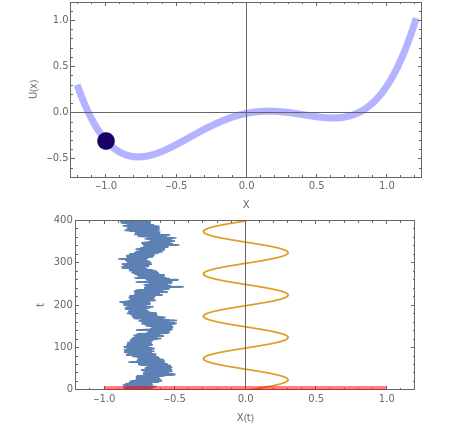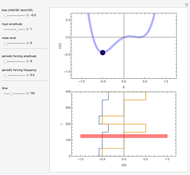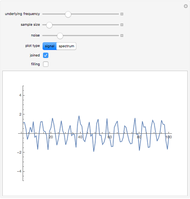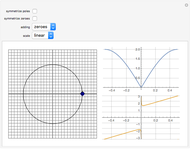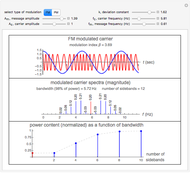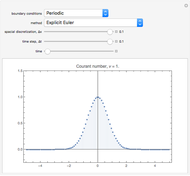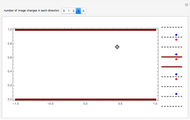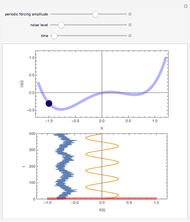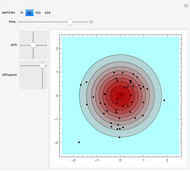Stochastic Resonance

Requires a Wolfram Notebook System
Interact on desktop, mobile and cloud with the free Wolfram Player or other Wolfram Language products.
Sometimes adding the right amount of noise can increase the signal-to-noise ratio of a signal; this is called stochastic resonance. In this Demonstration you can follow the time evolution of a particle inside a bistable potential with a low-amplitude, periodic forcing. Usually, that forcing is not enough to switch the particle from one stability basin to the other. But a small amount of random noise makes the particle oscillate between the two basins, following the periodic forcing.
Contributed by: Alejandro Luque Estepa (March 2011)
Open content licensed under CC BY-NC-SA
Snapshots
Details
Consider the following stochastic equation:
 ,
,
where  stands for a Wiener process and
stands for a Wiener process and  represents the noise level.
represents the noise level.
Now consider potentials of the form  , composed of a stationary part
, composed of a stationary part  with two minima at
with two minima at  and
and  and a periodic forcing with amplitude
and a periodic forcing with amplitude  and period
and period  . If
. If  is small enough,
is small enough,  will oscillate around either
will oscillate around either  or
or  , without ever switching to the other.
, without ever switching to the other.
But what happens if one increases the noise amplitude  ? Then there is some probability that
? Then there is some probability that  will jump from one basin to the other. If the noise level is just right,
will jump from one basin to the other. If the noise level is just right,  will follow the periodic forcing and oscillate between
will follow the periodic forcing and oscillate between  and
and  with period
with period  . This is what we mean by stochastic resonance.
. This is what we mean by stochastic resonance.
In more general terms, there is stochastic resonance whenever adding noise to a system improves its performance or, in the language of signal processing, increases its signal-to-noise ratio. Note that the noise amplitude cannot be too large or the system can become completely random.
Further reading:
A. Bulsara and L. Gammaitoni, "Tuning in to Noise," Physics Today, 49(3), 1996 pp. 39-45. L. Gammaitoni, P. Hänggi, P. Jung, and F. Marchesoni, "Stochastic Resonance," Reviews of Modern Physics, 70(1), 1998 pp. 223-287. S. Herrmann and P. Imkeller, "Stochastic Resonance," in the Encyclopedia of Mathematical Physics, Amsterdam: Elsevier, 2006. F. Marchesoni, "Order out of Noise," Physics, 2(23), 2009.
Permanent Citation
